What Makes An Adaptation Canon?
Thoughts on the matter in general, and why I’m glad I gave 'Rings of Power' a chance
Mae govannen, friends! Josh here. For the month of October I’m taking a break from my usual schedule as my family adjusts to the addition of a new little Hobbit! But I’ve lined up a great slate of guest writers to keep the Tolkien content flowing.
Today’s guest post comes to us from Samantha Coté, who has written for Jokien with Tolkien previously and who writes here on Substack at THOUGHTMOOT.
Today Samantha has written on the idea of ‘canon’ and discusses it both general and with regards to The Rings of Power (RoP). I appreciated the nuance she draws out and how she applies it to RoP. Hope you enjoy!
What Makes An Adaptation Canon?
Thoughts on the matter in general, and why I’m glad I gave Rings of Power a chance
By
Is your favorite film adaptation truly ‘canon’?
Die-hard fans of the original Lord of the Rings film trilogy would answer emphatically, yes. A love for the movies is an essential part of basic membership in the Lord of the Rings fan club!
Those more skeptical of adaptations in general would argue, definitely not. The elves don’t even sing fanciful tunes as they traipse gaily through the forest! It’s a disgrace to Tolkien’s legacy.
With each new film traversal into your favorite fantasy universe, you will find yourself asking the questions over again: what does ‘canon’ actually mean? And whose interpretation of it is right?
If I may, I’d like to offer my own humble opinion on the subject. While I obviously think is the most right, if you disagree, feel free to set me aflame in the comments. I’m no Tolkien scholar, just a lover of stories.
Since finishing season one of The Rings of Power (RoP), I’ve been mulling the question of canon over and over, and I’ve found my conclusions surprisingly hard to articulate. I’ll say up front that as an amateur historian, it’s always hard for me to swallow film adaptations that stray from chronological canon, so my foray into RoP initially felt pretty jarring. After piecing the timeline back together through some frantic research on Tolkien legendarium websites (I’ve read The Silmarillion, but sadly don’t possess a photographic memory, so judge me gently, please), I felt like I’d just gotten lost in a mirror maze for three hours. And yet, despite some admittedly befuddling adaptation choices by the makers of RoP, I got sucked in.
I got sucked into the scope, the danger, the courageous resistance to impossible odds. I got sucked into the beauty and the intrigue and the feeling of discovery as familiar names appeared on-screen in the flesh. The show inspired me to explore and engage with Tolkien lore in new ways. And by the end of the season, I found my gut wanting to welcome RoP into The Lord of the Rings canon if I could. This after two years of refusing to watch it because I love the original film trilogy, and the books, so much!
How was this possible? Can the canonization of a piece of storytelling really be determined purely by a gut feeling?
The answer, I think, is yes… and no. Hear me out.
A Thing of Spirit as well as Craft
There are, of course, some general rules most fans of any franchise will accept. If an adaptation departs too drastically from the original canon, unrecognizably altering beloved characters, injecting unnecessary anachronisms, or changing the ultimate meaning, or landing, of the story, it will be much harder to accept that adaptation into the canon of a universe.
Many fans would have rioted, for instance, if the Frodo of the LOTR films had tossed the Ring into the fires of Mount Doom all of his own accord, or if Aragorn had ultimately decided to renounce his rightful place as King, or if Samwise had been thin and uninterested in potatoes. Indeed, as faithful as the LOTR films are to the original story, there are still many alterations which some find too offensive for the films to be considered canon.
It’s certainly possible for an adaptation to butcher a story so decisively in its essentials that it no longer resembles the work of art it’s based on (I can think of a few examples of this). But it’s not always about chronology and who says which lines. Oftentimes the biggest strains on an adaptation’s canonicity come from thematic undertones or changes in characters’ personalities, and this is the area where fans tend to split into two camps. You’ll find a lot of Harry Potter fans are content to let it slide when none of the Hogwarts students in the later movies wear wizards’ hats and robes. But no sane person would stand idly by if they had portrayed Lord Voldemort as a misunderstood, sensitive guy, or wrapped up the franchise early by having him get eaten by a dragon in the third movie. The films then would have lost something beyond plain historical accuracy.
What this indicates to me is that there are two levels to canon: the literal and the spiritual, if you will. And the spiritual can be a lot less flexible than the literal.
As much as we hate to admit it, Annatar is just right about some things. In Season 2 Ep. 5 he tells Celebrimbor that the creation of the Rings is a “thing of spirit as well as craft”—no doubt hinting at his own hidden influence over the Rings. As we see in Season 2 of RoP, what goes into a thing is not merely the materials that give it shape, but the purpose behind its creation, the intent and the values that moulded it. The same is true for stories and their adaptation.
We all know book canon is different than movie canon—and no adaptation is 100% faithful to its source material. We accept this because an adaptation is just another way of retelling a story—and what matters most is whether the adaptation reflects the heart of the story. It generally matters less what a character looks like than how they behave.
So, though literal canon is absolutely necessary at certain points for preserving the integrity of a story, it is spiritual canon that often holds more weight for fans, as long as the adaptation is made in good faith. This is why, more often than not, it’s your gut that will tell you whether a film or TV adaptation should be considered canon—and why devoted fans sometimes disagree wholeheartedly on the subject.
*The Rings of Power Season 1 & 2 spoilers ahead!*
When it comes to RoP, I have a few final thoughts.
The most open-hearted assessment of RoP will at the very least accept that 3000 years of Middle Earth history is a lot to cover in a single TV series. I don’t blame them for abbreviating the timeline—in fact, I actually think that’s one of the less problematic adaptation choices they’ve made. In terms of major Middle-Earth-history events, RoP has so far stayed surprisingly faithful to the core conflicts surrounding them, though its creators clearly took some huge liberties with connecting story material.
Going into Season 2, I had some serious reservations about whether RoP would stay true to the fundamentals of Tolkien’s work, and the show certainly drops the ball on this in some significant ways.
RoP rarely pulls its punches in terms of violence and gore, which makes it feel considerably darker than the original source material, or even past LOTR adaptations. This isn’t always a liability, but I find the show sometimes undermines itself with raw portrayals of violence, especially against defenseless women (scenes like the tavern hostage scene in season one, and Mirdania’s demise in season two, come to mind). That doesn’t seem to fit with the general attitude of Tolkien toward women, which I think gave them more dignity even as victims of violence. Though, to be fair, portrayals of heroines like Bronwyn in season one and one very valiant Elven archer, Rían, in season two, did feel more on-brand to me.
I also found season two’s piece about Adar and the orcs wanting to live the simple life in Mordor with their families hard to swallow. For a good part of the season, this storyline felt off—just not quite true to Tolkien’s vision of the lines between good and evil in Middle Earth.1 I did think they pulled it together well in that spectacular season finale, though, as Adar finally learned the hard way that his vision of peace between Uruks and Elves did not align with his children’s.
Those complaints aside, many things RoP has done so far stand out to me as true to the heart of Tolkien’s work.
Its visual depiction of Tolkien’s world is stunningly beautiful, and though the timeline may give some fans a headache, it’s obvious the creators took a lot of care to bring things together cohesively. And thematically, so much of the story radiates the spirit of Tolkien: Annatar’s genius manipulation of the Elven smiths, Galadriel’s struggle against pride and ambition, Númenor’s decline from a bastion of wealth into a broiling civil conflict. One of the strongest moments in season two, though tragic, was Celebrimbor’s valiant defiance of Sauron—even in the midst of torment, even to the point of death. This thread of hope, of light’s triumph over darkness, runs through the show, all the way to the end of season two.
RoP shines the most in its compelling heroes and villains. People who struggle against darkness, against death, and against themselves, failing and rising again in defense of the same Good Sam Gamgee would one day come to fight for. People tormented by betrayal, lost in a desire for control, blinded by promises of power, willing to pay any cost to assert their will over others. These themes lie at the core of Tolkien’s work.
A New Tale in the Mythos of Middle-earth
As with any other film or TV adaptation, RoP will never align 100% with its original source material, but it contains something of its own internal canon—for better or for worse. Fans will disagree on changes to different elements, and that’s a beautiful thing! Ultimately, I think that allowing space for those deviations and missteps actually opens the door for the successes we hope to see when our favorite stories are adapted to the screen.
If we think of Middle-earth history as a kind of mythology (and I think there’s a good argument for that), then perhaps it isn’t too much of a stretch to say that The Rings of Power is a valid interpretation of the tale. Every mythology has been retold a million ways, successfully and unsuccessfully—but what makes a reimagining of a myth truly work is the degree to which it retains the core essence of the original story.
As far as I’m concerned, season two of RoP ultimately stayed true to this spirit. And I’m hopeful that future seasons will remain faithful to the deep truths of Tolkien lore, continue to lean into the goodness of the story’s heroes, and prove itself worthy of the “spiritual canon” name.
Discussion Questions
Do you also find there to be a distinction between "literal" and "spiritual" canon in adaptations of a work from one medium to another?
How might we apply this same idea of levels of canonicity to other adaptations, whether they're based on Tolkien or something else?
Rings of Power season 2 Review and Analysis in Jokien with Tolkien:
Season 2, Episodes 1–3:
S2 Episode 4, “Eldest”
S2 Episode 5, “Halls of Stone”
S2 Episode 6, “Where Is He?”
S2 Episode 7, “Doomed to Die”
S2 Episode 8, “Shadow and Flame
Appendices
Want to buy me a coffee during these weeks of late nights, early mornings, sleep deprivation, and seemingly endless diaper changes? To drop a few bucks in my tip jar for first coffee, second coffee, a cup with elevenses, and more, visit my Ko-fi. Or join the Jokien with Tolkien Extended Edition and support me while also getting access to the full archives of paid content, monthly subscriber discussions, and more! Join the Extended Edition today
Special shout-out to Keely W for joining the Extended Edition this week!
⚔️ If someone forward this email to you or you found it through social media or Google, I’d like to invite you to join 10,000+ subscribers in the Jokien with Tolkien community: Subscribe here and get a free gift just for joining!
🏹 Chosen as a Substack Featured Publication in 2023
🪓 Official merch available in the Jokien with Tolkien store
❌ All typos are precisely as intended
🔗 Links may be affiliate, which is a free-to-you way to support this newsletter where I earn a small commission on items you purchase
📚 Check out my e-book store for downloadable guides to Tolkien and analyses of his works
🗃️ Can’t wait till next week for more content? View the archive
🎯 Interested in writing a guest piece like the above? Or sponsoring this newsletter with an ad? Email me at JRRJokien@JRRJokien.com
Editor’s note: I (Josh) actually found this minor storyline to be well in line with Tolkien’s depiction of Good and Evil as well as his overall depiction of Orcs, but I think the fact that it worked for me and not for Samantha actually supports her overall argument that fans can and do disagree on these matters of spiritual canon!


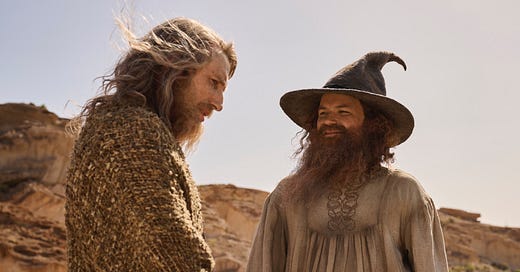



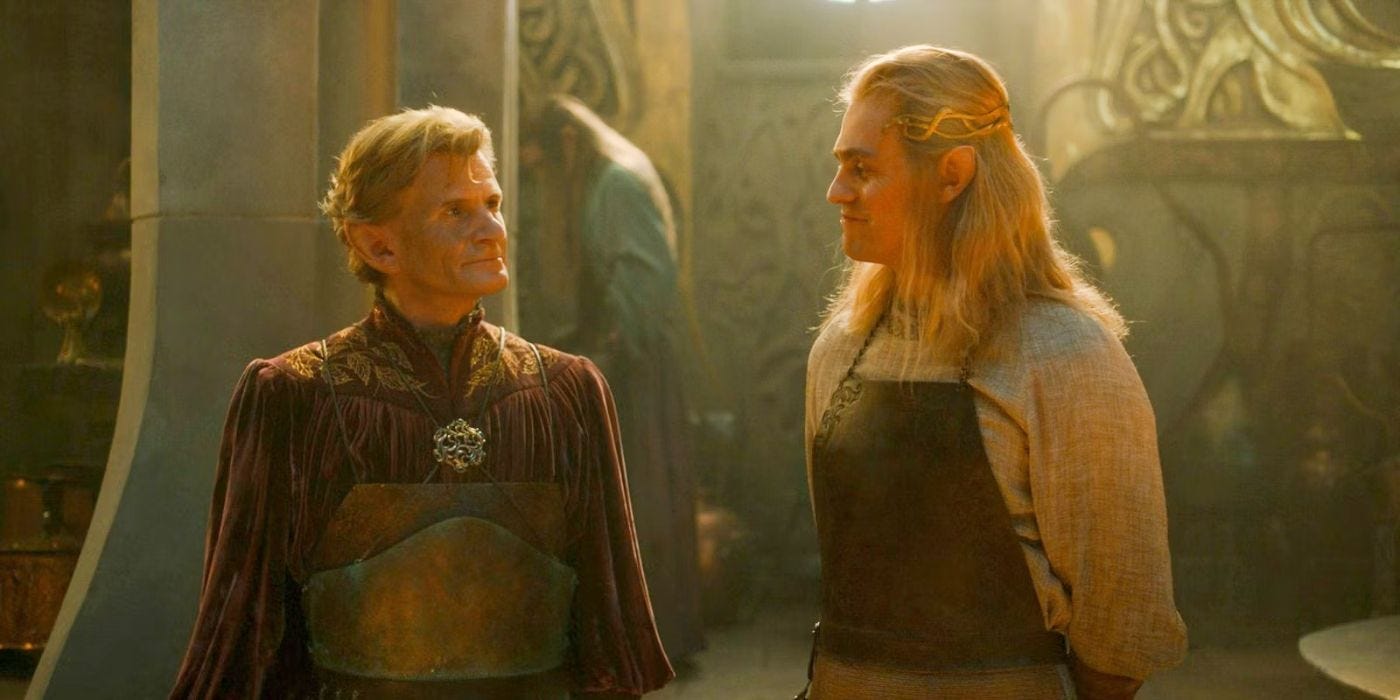
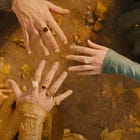
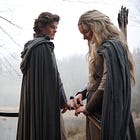
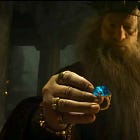
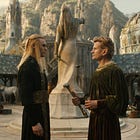
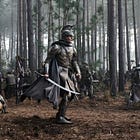



Well nuanced and thoughtful essay… I was challenged to consider how both “literal and spiritual interpretations” affect my thinking not only about the LOTR and RoP movies/series, but also my interactions with other media across many genres. This piece led to an interesting conversation between my hubster & I about how we can tend to do this with Biblical theology. How I learned to read and interpret the Bible in my teens has changed greatly now that I’m in my 70s! The literal Bible hasn’t budged, but my “spirituality” sure has, thank G-D!
The line about Sam and potatoes is hilarious and true. I think I agree with you about literal and spiritual, though I’ve never thought of it that way before.